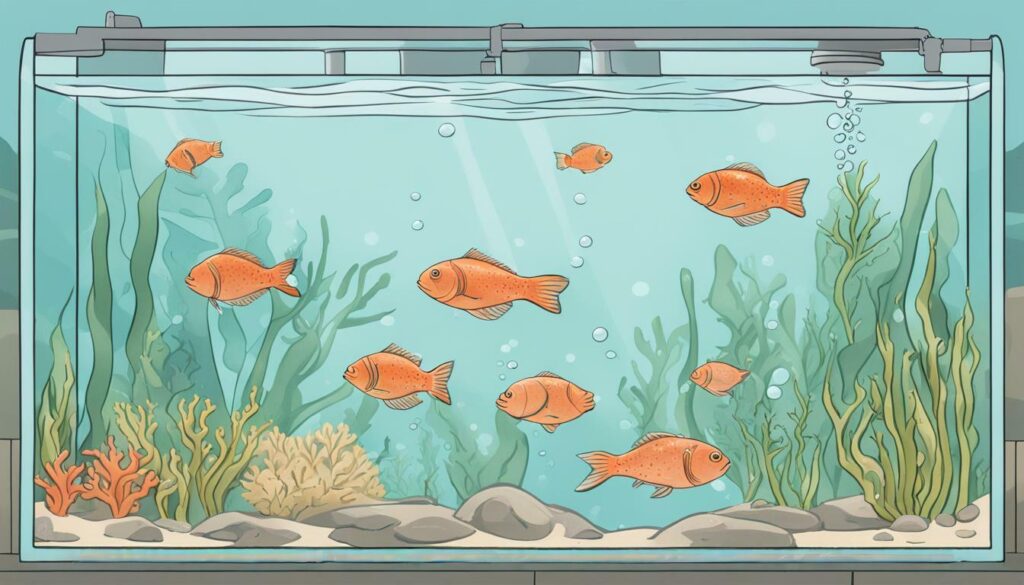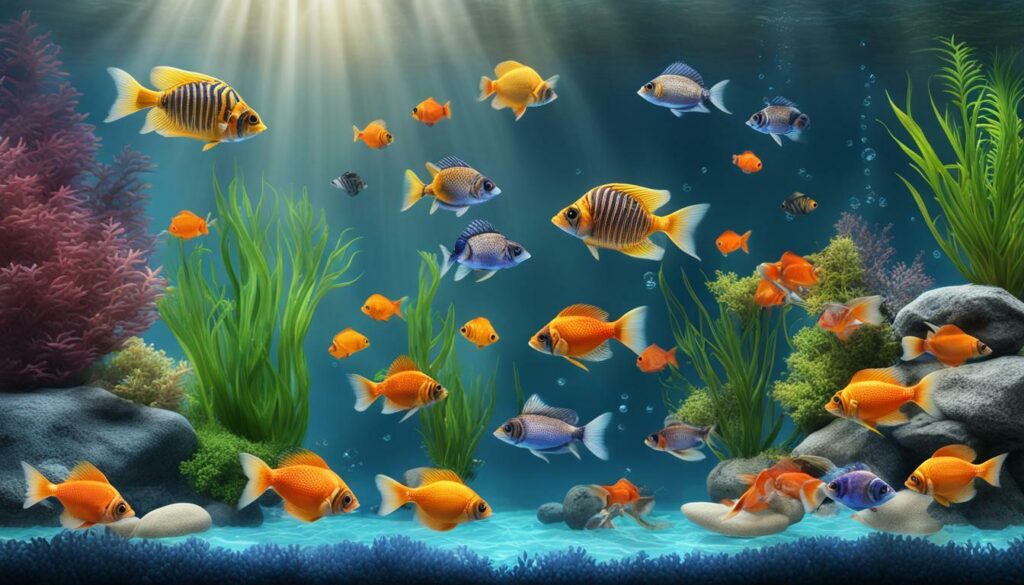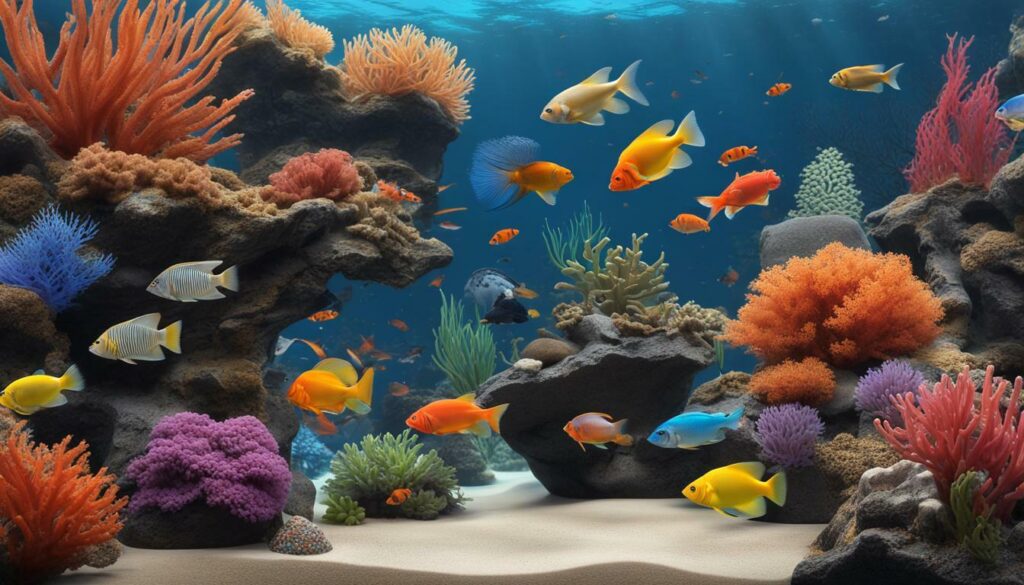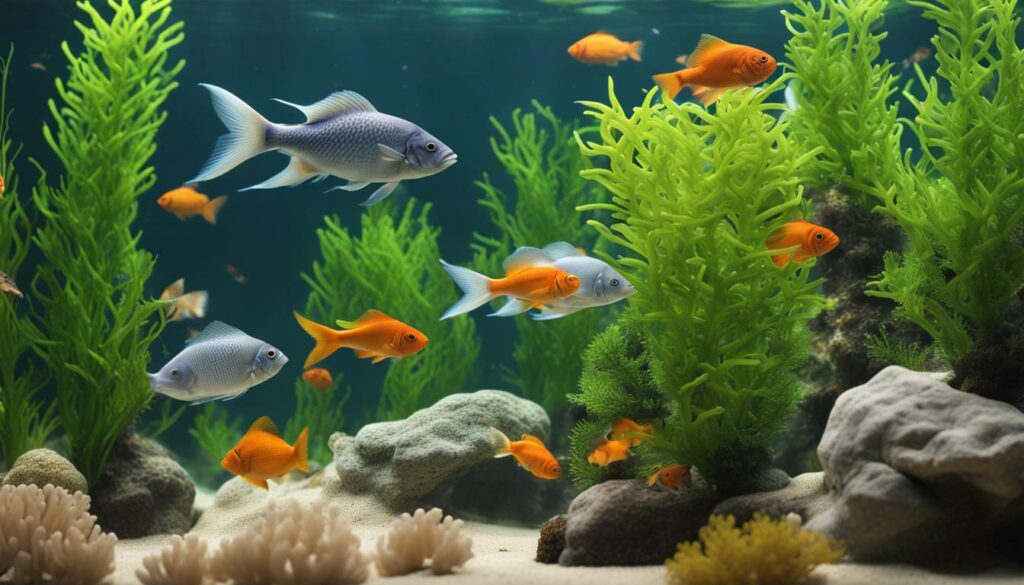Welcome to our comprehensive guide on aquarium fish gill disease. As aquarium owners, we all want our fish to be healthy and happy. However, fish gill disease is a common problem that can be fatal if not identified and treated early on. In this guide, we will provide you with essential information on how to recognize, prevent, and treat fish gill disease.
One of the significant issues regarding fish gill disease is that it’s often mistaken as common fish ailments. For example, fish owners may assume that their fish are merely displaying symptoms of stress, when in fact, their gills are inflamed. Therefore, it’s crucial to understand the symptoms and causes of fish gill disease to maintain your fish’s health effectively.
Key Takeaways
- Aquarium fish gill disease is a severe and potentially fatal issue that is often misdiagnosed as common fish problems.
- To maintain your fish’s health, it’s crucial to identify the symptoms and causes of fish gill disease early on.
- Preventing fish gill disease involves proactive care, including maintaining optimal water quality, creating a stress-free environment, providing balanced nutrition, and following proper quarantine procedures.
- Treatment options for fish gill disease range from natural remedies like aquarium salt to medication-based therapies. For severe cases, consulting a veterinarian is essential.
Understanding Aquarium Fish Gill Disease
As responsible aquarium owners, it’s essential to understand the common fish diseases that can affect the health of your fish. One such disease is aquarium fish gill disease, which can significantly impact your fish’s respiratory system and overall vitality.
Aquarium fish gill disease occurs when the gills become inflamed due to bacterial or fungal infections. The disease can spread quickly, affecting the ability of your fish to breathe, leading to a range of issues, including lethargy, appetite loss, and even death.
It’s crucial to be able to identify the symptoms of fish gill disease early on, so you can take proactive measures to stop it in its tracks. Some common signs to look out for include rapid gill movement, increased mucus, red or white patches on the gills, and labored breathing.
Causes of Aquarium Fish Gill Disease
There are several causes of aquarium fish gill disease, including poor water quality, overstocking, and overcrowding. Poor nutrition and high levels of stress can also contribute to the disease’s onset. It’s important to maintain good water quality by regularly testing the water parameters and ensuring that the pH levels, ammonia, and nitrate readings are within the appropriate range.
Overcrowding the tank and not providing enough space for the fish to swim can also lead to the onset of fish gill disease. Additionally, overfeeding your fish can lead to excessive waste buildup, which can lead to poor water quality and increased stress levels.

Importance of Proper Fish Health Care
Prevention is always better than cure when it comes to fish diseases, and proper fish health care is key to avoiding aquarium fish gill disease. Ensuring that the tank environment is clean and well-maintained, and that your fish receive a balanced and nutritious diet, can go a long way in maintaining their health.
Regular observation of your fish’s behavior and monitoring for any signs of distress or disease can help identify problems early, allowing for prompt and effective treatment. Additionally, it’s crucial to isolate any new fish for a quarantine period before introducing them to the existing aquarium population to prevent the spread of disease.
By understanding the causes and symptoms of aquarium fish gill disease and taking preventative measures, you can help keep your fish healthy and thriving.
Recognizing Symptoms of Fish Gill Disease
When it comes to fish gill disease, recognizing the symptoms early on is key to preventing further complications. Here are some of the most common symptoms to look out for:
| Symptoms | Description |
|---|---|
| Heavy breathing or gasping at the water’s surface | This is a sign that your fish is not getting enough oxygen due to gill damage or inflammation. |
| Increased mucus production on the gills | Excess mucus can indicate gill irritation or infection. |
| Swollen or discolored gills | Gills that appear red, inflamed, or swollen can indicate an infection or other health issue. |
| Decreased appetite and lethargy | Illness often leads to loss of appetite and decreased activity levels in fish. |
If you notice any of these symptoms in your fish, it’s important to take action immediately. Early treatment can often prevent the disease from spreading and causing further harm.
Image source: 
Prevention of Fish Gill Disease
Now that we understand the causes and symptoms of fish gill disease, let’s talk about prevention. To keep your aquarium fish healthy, it’s essential to maintain good water quality, provide a balanced diet, and create a stress-free environment.
Water Quality
Regular water testing is critical to maintaining optimal water quality in your aquarium. The parameters that need to be monitored include pH levels, ammonia, and nitrate levels. Ensure that you are maintaining appropriate water conditions by conducting regular water changes and using a reliable filtration system. Avoid over-crowding the tank and be cautious when adding new fish to the aquarium.
Nutrition
A balanced and nutritious diet is essential for healthy fish gill function. Choose high-quality fish food that contains a variety of nutrients, including protein, vitamins, and minerals. Follow a consistent feeding schedule, and avoid overfeeding, which can lead to excess waste in the tank and poor water quality.
Stress-Free Environment
The environment in your aquarium can have a significant impact on fish health. Ensure that you are providing the appropriate tank size and suitable tank mates to reduce stress in your fish. Proper acclimation procedures should also be followed when adding new fish to the tank. Pay attention to environmental factors that can cause stress, such as sudden changes in temperature and lighting.
Quarantine Procedures
Quarantining new fish is an essential preventive measure to avoid the spread of fish gill disease and other common fish ailments. Isolate new arrivals in a separate tank for a minimum of two weeks, and monitor for any signs of illness. They should not be added to the main tank until they have been cleared of any disease.

Preventing fish gill disease is critical to maintaining the overall health of your aquarium. By following the tips outlined above, you can reduce the risk of illness in your fish and ensure that they live long and healthy lives.
Treatment Options for Fish Gill Disease
When it comes to treating fish gill disease, there are a few options available. The choice of treatment will depend on the severity of the disease and the preferences of the fish owner.
Aquarium Salt: One natural treatment option is the use of aquarium salt. This can help to reduce swelling in the gills and improve the fish’s ability to breathe. However, it is important to use a salt specifically formulated for aquarium use, as table salt or sea salt can be harmful to fish.

Medications: In more severe cases, medication-based treatments may be necessary. There are a few different medications available, including those that specifically target gill disease. However, it is important to consult a veterinarian before administering any medications.
We recommend starting with the natural treatment option of aquarium salt and monitoring the fish’s progress. If the symptoms persist or worsen, then it may be necessary to consult a veterinarian and consider medication-based treatments.
Maintaining Aquatic Health: Best Practices
As aquarium owners, we want to ensure our fish are healthy and happy. Implementing best practices can go a long way in achieving this goal. Let’s take a look at some of the most important tips:
Regular Water Testing
Testing your aquarium water regularly is crucial in maintaining good water quality. Test for parameters such as pH levels, ammonia, nitrite, and nitrate levels. Keep a log of your test results to track changes and identify any potential issues. Consider using a digital testing kit for more accurate readings.
Proper Filtration
Investing in a quality filtration system is essential for maintaining good water quality and ensuring the health of your fish. Choose a filter that is suitable for the size of your aquarium and the number of fish you have. Regularly clean and maintain your filter to keep it working efficiently.
Regular Aquarium Maintenance Routines
Regular maintenance routines are crucial in keeping your aquarium clean and healthy. This includes weekly water changes, cleaning the substrate, and removing any debris or uneaten food. Scrub the walls of the aquarium to remove any algae buildup. Check and replace any faulty equipment immediately.

Quarantine Procedures for New Fish
New fish should always be quarantined before introducing them to your aquarium. This prevents the spread of diseases, including fish gill disease, to the rest of your fish population. A separate tank can be used for quarantine, ensuring that the new fish are healthy and free of any illnesses. Monitor their behavior and observe for any symptoms of fish disease.
The Importance of Temperature Control
Temperature control is crucial in maintaining the health of your fish. Invest in a quality aquarium heater to regulate the water temperature. Keep the temperature consistent and avoid fluctuations that can cause stress and illness in fish. Monitor the temperature regularly to ensure it remains within the preferred range for your fish species.
By following these best practices, we can ensure the health and well-being of our aquarium friends. Regular maintenance and monitoring can prevent issues from arising, and early detection is key in treating any potential illnesses.
Importance of Water Quality
When it comes to maintaining the health of your aquarium fish, water quality is crucial. Poor water quality can lead to a variety of health problems for your fish, including fish gill disease. Therefore, it is essential to monitor the water parameters regularly to ensure that the conditions remain suitable for your fish.
The most critical water parameters to monitor are pH levels, ammonia, and nitrate levels. Maintaining appropriate pH levels can affect how well your fish absorb oxygen through their gills. High ammonia and nitrate levels can cause stress and weaken the immune system of your fish, making them more susceptible to diseases.

There are several ways to maintain good water quality in your aquarium. Regular water testing, regular water changes, and proper filtration are some of the most important factors to consider. Depending on the size of your aquarium and the number of fish, water changes should be performed weekly or biweekly. Additionally, proper filtration can help remove toxins and other harmful substances from the water and support the growth of beneficial bacteria.
In conclusion, maintaining good water quality is essential to prevent fish gill disease, and other common fish diseases. Regular monitoring of water parameters, water changes, and proper filtration can help ensure that your fish remain healthy and happy in their aquatic environment.
Nutrition for Healthy Gill Function
Proper nutrition is critical for maintaining healthy gill function in aquarium fish. A balanced and nutritious diet helps to boost a fish’s immune system and prevent diseases, including fish gill disease. Here are some fish health tips for ensuring the optimal nutrition of your aquarium fish:
- Choose a high-quality fish food: Look for a fish food that provides a balanced diet with all of the necessary vitamins and nutrients. You can find a wide variety of fish foods on the market, including flakes, pellets, and frozen or live foods. Check the ingredients list to ensure that the food meets the dietary needs of your fish.
- Feed your fish appropriately: Overfeeding can lead to excess waste in the aquarium and poor water quality. Follow a regular feeding schedule and only feed your fish the amount that they can consume in a few minutes.
- Vary your fish’s diet: Just like humans, fish benefit from a varied diet. Offer your fish a mix of different foods to ensure that they receive a range of nutrients.
| Image related to Nutrition for Healthy Gill Function |
|---|
 |
By prioritizing proper nutrition in your fish’s diet, you can help to prevent a range of fish diseases, including fish gill disease. Remember to feed your fish appropriately, choose high-quality fish food, and vary your fish’s diet to maintain healthy gill function.
Creating a Stress-Free Environment
When it comes to maintaining the health of your aquarium fish, it is crucial to create a stress-free environment. Stress can weaken the immune system of fish, making them more susceptible to diseases such as fish gill disease. Below are some tips to help you create a stress-free environment:
- Choose Suitable Tank Mates: It is essential to choose appropriate tank mates for your fish to create a peaceful tank environment. Avoid adding aggressive or territorial fish that can bully other fish and cause stress. Research the compatibility of different fish species before adding them to your tank.
- Proper Acclimation Procedures: When adding new fish to your aquarium, make sure to follow proper acclimation procedures to reduce stress levels. Allow the new fish to adjust to the temperature and water conditions of your aquarium in a separate container before adding them to the tank.
- Environmental Factors: Environmental factors can also contribute to stress levels in fish. Ensure that the aquarium’s temperature, lighting, and water flow are suitable for the fish species you have. Provide suitable hiding places and adequate space to swim and explore.
By following these tips, you can help reduce stress levels in your aquarium and prevent fish gill disease. Remember, a stress-free environment is essential for the overall health and well-being of your fish!

Quarantine Procedures for New Fish
Introducing new fish into your aquarium can be a risky procedure, as it can lead to the spread of diseases such as fish gill disease among your existing fish population. That’s why we recommend implementing proper quarantine procedures to ensure the health and safety of your aquatic pets.
The first step is to set up a separate quarantine tank with a filtration system and heater. This tank should be kept away from your main aquarium to prevent any cross-contamination. When selecting new fish, be sure to choose healthy specimens and avoid any visibly sick fish.
Once you bring your new fish home, it’s important to acclimate them to their new environment slowly. This can be done by floating the bag containing the fish in the quarantine tank for 15-20 minutes to let the temperatures equalize. Then, gradually add small amounts of water from the quarantine tank to the bag over the course of an hour or two, to allow the fish to adjust to the new water parameters.
The quarantine period itself should last a minimum of 2-4 weeks. During this time, keep a close eye on the new fish for any signs of illness, including fish gill problems. If you notice anything unusual, consult with a veterinarian as soon as possible.
Regular monitoring is also essential during and after the quarantine period. Use a separate net, gravel vacuum, and other aquarium maintenance tools to avoid cross-contamination between tanks.

By following these quarantine procedures, you can minimize the risk of introducing fish gill disease and other illnesses to your existing fish population. It’s a simple precaution that can make a big difference in the long-term health and happiness of your aquarium pets.
Essential Fish Health Care Tips
We know that preventing fish gill disease is crucial for maintaining the health of our aquarium fish. Here are some additional tips to help ensure the overall well-being of our fish:
- Observe your fish regularly: Watch your fish for any changes in behavior or appearance, as early detection of problems can often lead to successful treatment.
- Perform regular tank cleanings: Regular cleaning of the tank and filters helps to prevent the buildup of harmful bacteria and other contaminants that can negatively impact fish health.
- Invest in a high-quality filtration system: A proper filtration system is essential for maintaining water quality and reducing the risk of fish disease.
- Avoid overcrowding: Overcrowding can lead to increased stress levels in fish, making them more susceptible to disease.
- Quarantine new fish: As mentioned before, it’s crucial to quarantine new fish to prevent the spread of disease to the rest of the aquarium population.
By implementing these tips along with the prevention and treatment strategies discussed earlier, we can provide the best possible care for our aquarium fish and maintain their health and happiness for years to come.

Conclusion
We hope that this article has provided you with valuable insights into aquarium fish gill disease and ways to prevent and treat it. As responsible fish owners, it’s our duty to ensure the health and well-being of our aquatic friends. By following the fish health tips and proactive care practices discussed in this article, we can keep our fish healthy and happy.
Remember the Key Points
Always be on the lookout for symptoms of fish gill disease, such as labored breathing and discolored gills. Maintain good water quality and proper nutrition to enhance gill function and overall fish health. Create a stress-free environment for your fish and ensure proper acclimation for new arrivals. Lastly, implement sensible quarantine procedures for new fish to prevent the spread of disease to the existing aquarium population.
Consult a Professional
If you notice any severe symptoms in your fish, it’s crucial to consult a veterinarian who specializes in aquarium fish. They can provide a proper diagnosis and recommend the best course of treatment for your fish’s specific needs.
Remember, prevention is always better than cure. By implementing the best practices outlined in this article, we can safeguard our aquarium fish from gill disease and other common fish ailments. Let’s continue to provide the best possible care for our aquatic friends!
FAQ
Q: What are the symptoms of fish gill disease?
A: Some common symptoms of fish gill disease include rapid or labored breathing, gasping at the water surface, swollen or discolored gills, and lethargy.
Q: How can I prevent fish gill disease?
A: To prevent fish gill disease, it is important to maintain good water quality by regularly testing and monitoring parameters such as pH levels and ammonia levels. Proper nutrition, a stress-free environment, and quarantine procedures for new fish are also essential preventive measures.
Q: What are the treatment options for fish gill disease?
A: Treatment options for fish gill disease include both natural remedies, such as the use of aquarium salt, and medication-based treatments. Severe cases may require consultation with a veterinarian for appropriate medication.
Q: How can I maintain a stress-free environment for my fish?
A: To create a stress-free environment for your fish, it is important to choose suitable tank mates, properly acclimate new fish to the aquarium, and consider environmental factors such as temperature and lighting. Providing hiding places and minimizing disturbances also help reduce stress.
Q: Why is water quality important for fish health?
A: Water quality plays a vital role in fish health as poor water conditions can lead to stress, weakened immune systems, and increased susceptibility to diseases, including fish gill disease. Monitoring and maintaining appropriate water parameters are crucial for the well-being of aquarium fish.
Q: How often should I feed my fish?
A: It is important to feed your fish a balanced and nutritious diet according to their specific needs. Overfeeding should be avoided, and it is recommended to establish a regular feeding schedule to prevent excessive food waste and potential water quality issues.

